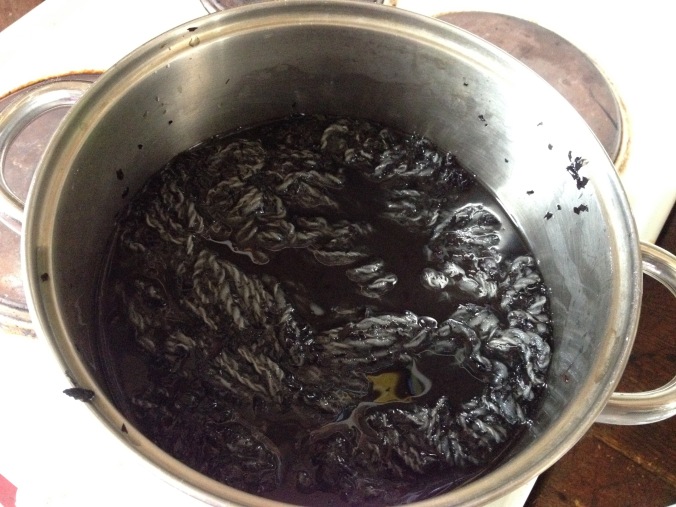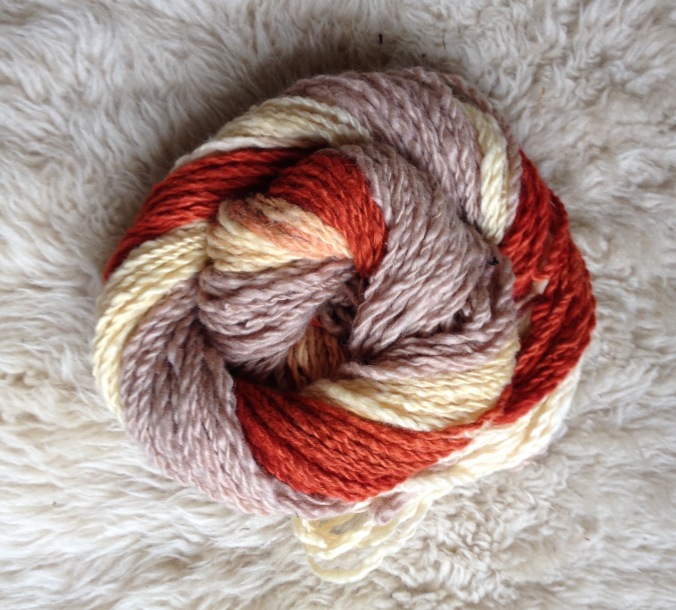Alkanet dye is derived from the root of the Alkanna tinctoria plant, a lovely but unassuming plant with periwinkle flowers typical of other members of the Borage family. Other names include anchusa, from the Greek anchousa, to paint, and its Latin name tinctoria similarly suggests its long history as a dye plant in Europe. In India, where it is more commonly used in cooking, it is called Ratan Jot. The colour produced ranges from wine reds to greyish blues, and has been used to dye plants, colour curries, stain woods, and ease the symptoms of leprosy.
The main colour compound is alkannin, which can range from red to violet depending on acidity. It does not appear to be one of the most important historic dyes, although it has clearly been in some use. This may be due to issues with lightfastness. While orchil dyes also produce a purple that is notoriously prone to light fading, the colour it produces is more dramatic and vibrant, which may have been another point against the use of alkanet in the past. Due to the questionable light fastness, I will not be offering fibres dyed with this yarn in my Etsy shop, and would encourage others to do the same.
Extraction
Alkanet dye is not particularly soluble in water, and for best results an alcohol extraction is required. I did this by filling a jar up with 100g of the chopped, dried roots that I purchased from George Weil and covering with really cheap vodka. I left this for two months in a dark place, out of laziness rather than determination.
Dye should then be strained and enough water added so that the wool can move about in the dye pot. I have to note that due to mental frailty caused by jetlag, I did not strain the fibres and for some cockamamie reason chucked it all in the pot together. Do not do this unless you want to be picking out pieces of root from your wool for the rest of your days on this planet.
Dyeing
I dyed 155 grams of my handspun organic merino wool, which put me at about 65% WOF using all of the dye extracted from 100g of root. I mordanted the wool in the bath with alum, using one heaping tablespoon of alum and cream of tartar. As I’ve previously mentioned, volume is not my preferred method, but for the time being I lack a scale.

I diluted the dye liquor 1:3 with water, which with all the root pieces, was really not enough space to achieve an even dye. I was worried about too much dilution, as I wanted a strong purple. This, along with the debris, resulted in an uneven colour, which is admittedly not unpleasant.
I warmed the dye and kept just below a simmer for 45 minutes. The deep purple colour did not start to develop until about a half hour in, up until which point it was a light, dull, blueish grey. Mixing seemed to help. As an aside, I wonder if there is some indigotin present in the root, as I noticed a change from purple to yellow as I decanted leftover liquor, which is typical of the oxidation reaction that occurs during indigo vat dyeing.
The yarn was pulled out, left to cool, and rinsed as per the usual procedure.
As mentioned, the skein was unevenly dyed, with some areas being more blueish and others more red. In spots where a piece of root became imbedded into the wool, there was often a red stain. It should knit up quite nicely, although there is still a smell about it that I can’t quite get behind.
Exhaust Dyeing
With the remaining, now strained liquor, I decided to see what would happen from an exhaust dye. Using a portion of some self-striping yarn I was making, and had previously dyed a portion of with madder, placed part of a skein of organic merino wool into the leftover dye. I followed the above procedure.
It is clear that alkanet gives most of its colour the first time around, and I only achieved a slightly purple light grey that I will likely dye over.

Self striping organic merino wool dyed with madder (red) and alkanet (grey). Alum mordant.
Summary:
- Poor lightfastness
- Best extracted with alcohol
- Lovely range of violets to dusty periwinkle with alum, more blackish greys with iron
- Do not boil
- Keep below simmer for 30-60 minutes
- Good colour requires 60-150% WOF
- Poor exhaust results
Note: WOF refers to weight of fibre, which is the amount (g) of dye/mordant/additive per weight (g) of fibre used. Madder at 100% WOF would mean 100g of root for 100g of fibre, while 50% WOF means 50g madder root for 100g of fibre.





Pingback: Bibliography – Rachel Moody Artist